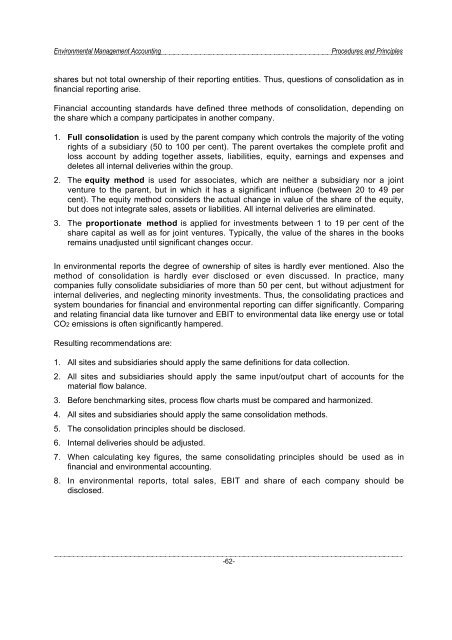Environmental Management Accounting Procedures and Principles
Environmental Management Accounting Procedures and Principles
Environmental Management Accounting Procedures and Principles
You also want an ePaper? Increase the reach of your titles
YUMPU automatically turns print PDFs into web optimized ePapers that Google loves.
<strong>Environmental</strong> <strong>Management</strong> <strong>Accounting</strong><br />
<strong>Procedures</strong> <strong>and</strong> <strong>Principles</strong><br />
shares but not total ownership of their reporting entities. Thus, questions of consolidation as in<br />
financial reporting arise.<br />
Financial accounting st<strong>and</strong>ards have defined three methods of consolidation, depending on<br />
the share which a company participates in another company.<br />
1. Full consolidation is used by the parent company which controls the majority of the voting<br />
rights of a subsidiary (50 to 100 per cent). The parent overtakes the complete profit <strong>and</strong><br />
loss account by adding together assets, liabilities, equity, earnings <strong>and</strong> expenses <strong>and</strong><br />
deletes all internal deliveries within the group.<br />
2. The equity method is used for associates, which are neither a subsidiary nor a joint<br />
venture to the parent, but in which it has a significant influence (between 20 to 49 per<br />
cent). The equity method considers the actual change in value of the share of the equity,<br />
but does not integrate sales, assets or liabilities. All internal deliveries are eliminated.<br />
3. The proportionate method is applied for investments between 1 to 19 per cent of the<br />
share capital as well as for joint ventures. Typically, the value of the shares in the books<br />
remains unadjusted until significant changes occur.<br />
In environmental reports the degree of ownership of sites is hardly ever mentioned. Also the<br />
method of consolidation is hardly ever disclosed or even discussed. In practice, many<br />
companies fully consolidate subsidiaries of more than 50 per cent, but without adjustment for<br />
internal deliveries, <strong>and</strong> neglecting minority investments. Thus, the consolidating practices <strong>and</strong><br />
system boundaries for financial <strong>and</strong> environmental reporting can differ significantly. Comparing<br />
<strong>and</strong> relating financial data like turnover <strong>and</strong> EBIT to environmental data like energy use or total<br />
CO2 emissions is often significantly hampered.<br />
Resulting recommendations are:<br />
1. All sites <strong>and</strong> subsidiaries should apply the same definitions for data collection.<br />
2. All sites <strong>and</strong> subsidiaries should apply the same input/output chart of accounts for the<br />
material flow balance.<br />
3. Before benchmarking sites, process flow charts must be compared <strong>and</strong> harmonized.<br />
4. All sites <strong>and</strong> subsidiaries should apply the same consolidation methods.<br />
5. The consolidation principles should be disclosed.<br />
6. Internal deliveries should be adjusted.<br />
7. When calculating key figures, the same consolidating principles should be used as in<br />
financial <strong>and</strong> environmental accounting.<br />
8. In environmental reports, total sales, EBIT <strong>and</strong> share of each company should be<br />
disclosed.<br />
-62-




